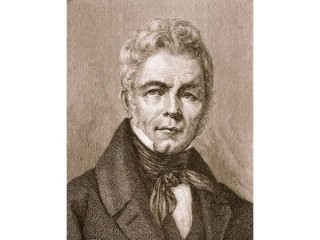
Karl Friedrich Schinkel biography
Date of birth : 1781-03-13
Date of death : 1841-10-09
Birthplace : Neuruppin, West Berlin, Germany
Nationality : German
Category : Arhitecture and Engineering
Last modified : 2011-08-31
Credited as : Architect, designer, and painter
The German architect, painter, and designer Karl Friedrich Schinkel was one of the most important and influential architects of his time. He was equally at home with the medieval and the classical tradition.
Karl Friedrich Schinkel was born on March 13, 1781, in Neuruppin west of Berlin; the family moved to the Prussian capital in 1794. Inspired by Friedrich Gilly's 1796 project for a monument to Frederick II (Frederick the Great), Schinkel turned to architecture and studied with Gilly (1798-1800). Schinkel traveled in Italy and France (1803-1804). He became a painter of romantic landscapes and panoramas (Medieval City by the Water, 1813) and stage sets (Magic Flute, 1815). In 1813 he designed the Iron Cross, Germany's highest military award. In 1815 Frederick William III appointed him Prussian state architect.
Although Schinkel designed important buildings for cities other than Berlin, such as the church of St. Nicholas in Potsdam (1826-1837) and the Guard House in Dresden (1833), his major works were erected in the capital. In fact, he reshaped the monumental center of the city, and before its destruction during WWII it was said that he who knew Berlin knew Schinkel. His first building was the Royal Guard House (Neue Wacht-Gebäude) on the Unter den Linden (1816). A stone block with Doric portico, it established Schinkel as a master of Neo-Greek forms.
The reshaping of the Lustgarten (now Marx-Engels-Platz), a square at the eastern end of the Unter den Linden in front of the Royal Palace (now demolished), occupied the architect's attention during the 1820s. He remodeled the Cathedral to the east, but his major work was a new museum (now the Altes Museum) opposite the palace (designed 1822; finished 1830). A low block with a central rotunda for sculpture flanked by courts and surrounded by galleries for paintings, the museum closed the north side of the square with a majestic row of 18 lonic columns framed by a podium below, entablature above, and pilasters to either side. The museum was Schinkel's masterpiece, one of the principal monuments of European neoclassicism and a continuing source of inspiration for classically oriented architects of the 20th century, such as Ludwig Mies van der Rohe and Philip Johnson.
Schinkel's other notable buildings in Berlin show the variety of his work. The Theater (Schauspielhaus) on the Gendarmenmarkt (1818; gutted 1945) sat on a podium with its Ionic portico contrasting with the low, flat, pilastered wings. The whole was capped by sculpture-enriched pediments. It was meant to form a unit with the porticoed and domed French and German churches that flank it. The
monument to Napoleon's defeat that still crowns the Kreuzberg is a cast-iron Gothic pinnacle designed in 1818 (finished 1821; site later altered). For the Friedrich Werder Church near the Lustgarten, Schinkel submitted alternative designs, one classical and one medieval; the existing church (finished 1831) is Neo-Gothic.
The School of Architecture (Bauakademie) on the Spree River near the Lustgarten (1831-1835; destroyed) was characteristic of Schinkel's later work. A simple redbrick block enriched on the exterior by shallow pilasters and restrained decoration, it was a direct statement of structure and enclosure without overt historical details. Schinkel was appointed professor of architecture at the academy in 1820, and through his students his influence continued long after his death. He died in Berlin on Oct. 9, 1841.
















